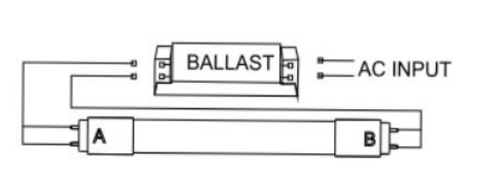The LED lights are often a little more expensive than fluorescent lights, but in the long run, LED lights are a better choice, both economically and environmentally. LED lights can last 50,000 to 100,000 hours, while fluorescent lights are 10-25% as long (roughly 10,000 hours), so an LED light can outlast 5 fluorescent ones (and probably their ballasts) on average. Also, LED lights are more energy-efficient, they are often above 50 lumens/watt, however, fluorescent lights are below 30 lumens/watt, which means you can save almost half the power cost on lighting if you use LED lights.
But how do we choose an LED light tube to replace a fluorescent one? Let’s start with some basics about LED lights.
There are mainly 4 types of LED tubes that you can choose from: Type A, Type B, Type A+B, and Type C.
Type A: Ballast Compatible
Commonly known as the “plug-and-play” type LED light tube, meaning you can uninstall the existing fluorescent tube and just replace it with a Type A LED tube.

Disadvantages: Fluorescent ballasts can fail, requiring continued maintenance and eventual replacement or bypass of the ballast; potential issues with fluorescent ballast compatibility; lower overall electrical efficiency due to ballast.
Type B: Ballast Bypass
This type of LED light tube is not compatible with a fluorescent ballast and must be connected to the mains electricity directly. Type B LED light tubes can be further categorized into single-ended and double-ended.
Single-ended
In a single-ended configuration, only the two pins on one end of the tube are used (one pin = live; one pin = neutral, often the labeled end), and the two pins on the other end are not electrically functional, and only used for holding the lamp in place.

In a double-ended configuration, the two pins on each side of the tube are connected inside and have the same polarity. Therefore, the lamp holder(s) on one end of the tube must be connected to [neutral], while the other end must be connected to [positive].

Disadvantages: requires comfort with and knowledge of fixture wiring and electrical safety.
Type A+B: Ballast Compatible / Bypass
This type of LED light tubes has the ability to operate off the existing fluorescent ballast and also has the ability to operate off of line voltage if the circuit is rewired to bypass the ballast. Note that due to testing considerations, at this time only products that can operate off specific ballasts types are eligible.

Disadvantages: Only works for specific ballast types and it either needs extra power to run the ballast or takes time and money to bypass it.
Type C: External Driver
This type of LED light tubes is usually uncommon but offers the most flexibility and efficiency for a lighting system. Unlike a Type B LED tube, these do not have the LED driver integrated into the LED tube, and therefore require a separate LED driver device to be connected between the LED tube and mains electricity. They also have single-ended and double-ended versions.

Disadvantages: Requires the most electrical work as the fluorescent ballast needs to be removed, then replaced with an LED driver.
Now that you have a brief idea of the 4 main types of LED light tubes, in the next blog we are going to talk about the LED tube holders (or generally called tombstones) each type of them is going to need. If you need any help deciding which type of LED light tube works best for you, please comment below or send us an email at service@jackyled.net.

